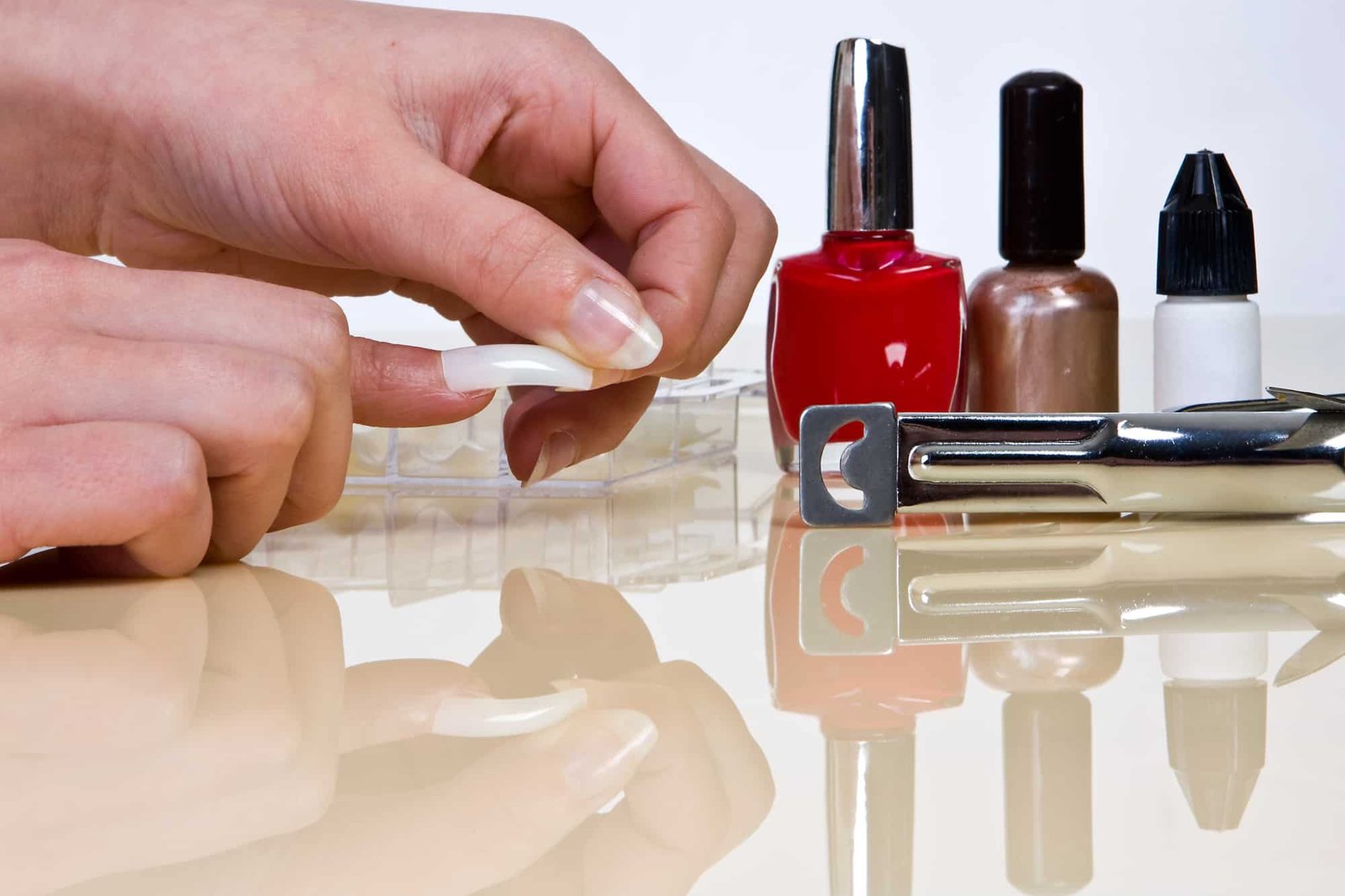Gorilla Glue is a well-known adhesive that can bond virtually anything. With its long-lasting effects, it’s no wonder that many people wonder if they can swap out their traditional nail glue with Gorilla Glue for a stronger hold.
You shouldn’t use Gorilla Glue on nails. Although Gorilla Glue and nail glue have the same active ingredient, they have different potencies and additional ingredients, making Gorilla Glue unsafe for skin and nails.
Although Gorilla Glue will lead to long-lasting false or acrylic nails, it can have damaging side effects. If you’ve ever been tempted to replace your nail glue with Gorilla Glue, keep reading to discover the risks and benefits.
Can I Put Gorilla Glue on My Fake/Acrylic Nails?
Visiting the nail salon can be a costly trip, with manicures costing up to $100. Using fake or acrylic nails is an affordable option for those who want the salon look without the high price tag.
Traditional and high-quality nail glues can be expensive, and applying fake nails with inexpensive nail glue often results in fake nails falling off.
You should not put Gorilla Glue on your fake or acrylic nails, especially without wearing gloves. Although many people have successfully tried it, using Gorilla Glue can be extremely harmful to your nail bed and the surrounding skin.
Gorilla Glue products have specific instructions on what to do if the glue comes into contact with your skin or nails. They also recommend wearing gloves when using the product to reduce the likelihood that your skin will come into contact with the glue.
However, If your false nail breaks, you can use Gorilla Glue to put it back together as long as you don’t put it directly on your nail bed. Despite its downsides, Gorilla glue is still an excellent adhesive that can restore a chipped, broken, or cracked artificial nail.
If your acrylic nail cracks, add a dab of Gorilla Glue to the fault line and glue the nail back together. In this case, you might need to repaint it to cover the crack. After gluing your nail back together, use nail glue to put it back onto your natural nail.
If your original fake nail falls off after you glued it on, don’t use Gorilla Glue to reattach it. Remove the original glue from your natural and false nail with acetone or nail polish remover.
(Source: L’Oreal Paris USA)
Give yourself a quick manicure by cleaning and buffing the nail, pushing back your cuticles, and trimming or filing your nail. With a clean surface, reattach the artificial nail using nail glue.
Is It Safe or Dangerous To Use Gorilla Glue on My Nails?
It is not safe to use Gorilla Glue on your nails. Since it is designed to bond instantly and for a long time, it hasn’t been approved for use on the skin. It is nearly impossible to remove once it’s bonded, and it can be excruciating to remove from sensitive areas.
Additionally, inhaling Gorilla Glue is dangerous and can cause you to feel dizzy or drowsy.
(Source: Gorilla Tough)
Gluing artificial nails requires you to be very close to your fingers so that you can clearly see your work. Being that close to Gorilla Glue is dangerous because you may accidentally inhale it. You need to use Gorilla Glue in well-ventilated and open-air areas.
Nail glue and Gorilla Glue are both made from cyanoacrylate. However, Gorilla Glue is a much stronger grade of cyanoacrylate and can permanently bond the skin together. Nail glue won’t harm your skin as much as Gorilla Glue.

When gluing false nails, the nail glue often gets on your skin, and Gorilla Glue is runnier than traditional nail glue, which increases the likelihood of it getting on your skin.
If your fingers get stuck together using nail glue, you can easily pull them apart or use nail polish remover as a solvent to separate them. Gorilla Glue will bond your skin much faster and requires you to drench the affected area with water for at least 15 minutes to remove it.
Does Using Gorilla Glue Ruin Your Nails? Is It Bad?
Using Gorilla Glue won’t ruin your nails as long as you are very careful. Damage mainly occurs when attempting to remove the glue from your nails. However, it can significantly weaken your nails and cause them to break easily over time.
Although many DIY nail artists recommend using acetone, a standard nail polish remover, to remove the glue from your nails, the Gorilla Glue manufacturers don’t recommend using acetone to remove Gorilla Glue from your skin or nails.
Gorilla Glue recommends using a gritty soap and water or a tough exfoliator.
(Source: Gorilla Tough)
Without using powerful products like acetone or alcohol, removing glue from your nails after the adhesive has been on for several weeks is exceptionally challenging, painful, and nearly impossible. This can damage your skin and leave you with weak nail beds.
If you choose to remove the glue using acetone or a nail polish remover, be prepared to wait a long time and have patience as the acetone works its way through the bond. This process can burn, and it might result in you tugging at the artificial nail to loosen its grip. This process can damage your nail bed.
It’s more likely that you’ll harm your skin rather than your nails while using Gorilla Glue. Gorilla Glue has several hazard warnings on the label. It can burn or cause allergic reactions, and prolonged exposure to Gorilla Glue can irritate the skin.
When Gorilla Glue comes in contact with water, it naturally expands. That’s why the manufacturers suggest you moisten the surface you want to glue before you use Gorilla Glue so that you achieve the maximum adhesiveness.
As you wash your hands, do the dishes, shower, or come into contact with water daily, the Gorilla Glue under your nail can expand. This expansion causes tiny bubbles in the Gorilla Glue and can cause your false nail to lift.
As your nail lifts, it can trap excess moisture and dirt on your nail, which can lead to infections and a foul odor.
How Long Does Gorilla Glue Last on Nails?
Gorilla Glue lasts about a month on nails. While traditional nail glue generally lasts up to two weeks maximum, Gorilla Glue is much more hardy and will last for longer on false or acrylic nails.
The appeal of using Gorilla Glue is that it’ll last about two times longer, and you can be rougher with your hands because you don’t have to worry about your fake nails falling off as easily as they would using traditional nail glue.
Although the glue might last several weeks, the nail polish might not. Depending on the nail polish you used, you might have to repaint them after a few weeks or touch your nails up as needed to keep your manicure looking fresh.

Why You Should Use Nail Glue vs. Gorilla Glue
You should use nail glue rather than Gorilla Glue because it is much safer to use, and you won’t have to worry about damaging your skin or inhaling toxic fumes while you glue your artificial nails.
Although traditional nail glue isn’t as strong as superglues like Gorilla Glue, there are highly durable nail glues that’ll help your nails last for weeks.
Another benefit of using nail glue is that you can also purchase different types of nail glue for your needs. For example, there are nail glues that are ideal for people with sensitive skin.
There is also fast-drying nail glue, and glue that is excellent for split or cracked nails, press ons, or acrylic nails. With such a wide variety of options, you can find a nail glue that’s best for your situation.
Additionally, it’s best to give your nails rest from glues and artificial nails, as moisture can seep in between your natural nail and your artificial nail. Bonding your nails for a month with superglue allows dirt to build up quickly.
If you dissolve the nail glue from your nails every two to three weeks, you’ll keep your nails fresh and clean.
Final Thoughts
It may be tempting to trade your nail glue for Gorilla Glue, but it’s usually better to opt for other types of nail glue. Either way, always use safe materials for any at-home nail work.










